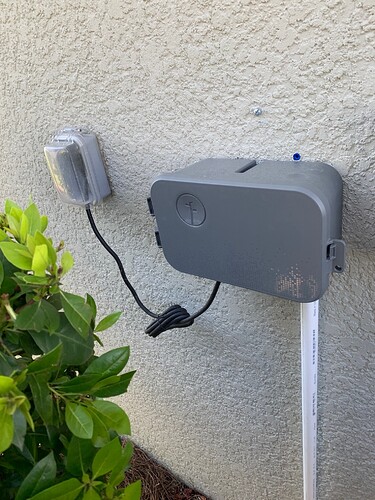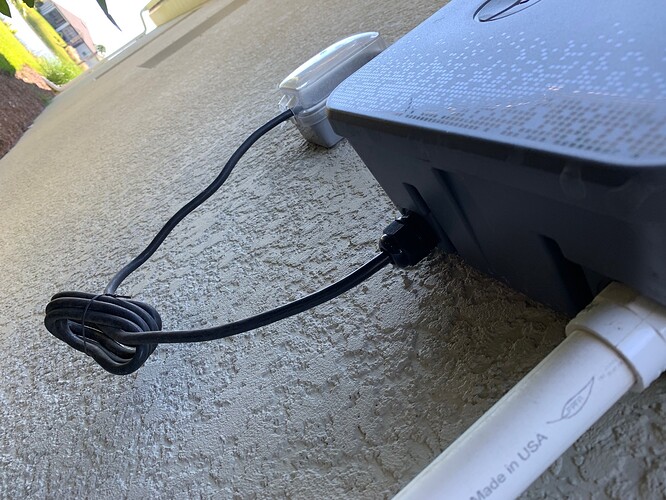I need to install my controller where there is no 110v power (near my 220v pump), replacing an intermatic timer with a rachio and a pump start relay. It appears the controller power adapter is rated for only 110v input. What solution options are possible?
If you have a bare ground wire, you can use it in lieu of neutral to get 110v with any one of the two hot wires you have coming in. In the main breaker the neutral and ground are tied together, so it’s a common way to get 110v for air-conditioner installs and the like.
I would advise against doing that. It does not meet the National Electrical Code and is not safe. Grounds are not to be used as current carrying conductors. A safer option would be to install an appropriately rated 240 to 120 volt transformer installed by an electrician who knows what they are doing. You could also run a separate neutral back to the circuit breaker panel if the wiring would make that feasible. Another option is to order a 240 volt power supply from Rachio. I would imagine they make one for the European market.
As @kd4cw4679 says, or get a 240V → 24V transformer (rated for at least 1 A out) in place of Rachio’s supply. You could cut the output cord to have a connector that mates with the controller. For example:
While I agree that NEC may frown on using Ground wire as neutral, it’s only unsafe as far as disconnecting the ground wire from the bus at the breaker while the power is on (for a dedicated run, as I expect is in this case). For a 24VA load of the rachio transformer, voltage drop across the wire will be negligible. 240V runs tend to be dedicated (as in from the breaker to the pump controller, uninterrupted). Danger arises in case someone tries to do this on the light or outlet circuit and then, without knowing, disconnects the ground while keeping the power ON (which is dangerous no matter what), in this case live voltage (110V) can develop on the ground wire and should you touch it without protection, it may shock you.
As I’ve said it’s a common practice in the AC field, used to run condensation pumps and UV lights. That being said, if you are in the position to easily run a neutral and/or a whole new 110V run, that’s the best option, 240V transformer is also a good, though not very pretty, option (Rachio doesn’t sell those), while using GND in lieu of neutral will perhaps the the cheapest / quickest way to get 110V you need, you need to remember to always turn off the breaker while working with mains voltage (something you should be doing anyway).
It is not a case of the “NEC may frown on it”. Most local jurisdictions have adopted the NEC into law and technically if you violate the NEC you are violating the law. Now realistically what you propose will work under normal circumstances. I am surprised a reputable HVAC contractor would do that however.
The reason the NEC prohibits using the equipment grounding conductor as a neutral is that the return current causes a voltage drop so that the grounded parts of the equipment may be at some potential above ground. Practically it will only be a few volts but could be higher if a heavier load like a tool is plugged in to the receptacle. Using the ground as a neutral also means the path back to the neutral in the panel is no longer defined. Current can flow back through the ground conductor but it can also take other paths through the ground.
Oddly the NEC for years allowed one exception to this rule. Beginning during World War II it allowed the neutral of an electric range circuit to also be used to ground the range frame and did not require a separate equipment grounding conductor. An old time EE told me this exception was put in the NEC to save copper during the War. The exception was removed sometime in the 1980’s I believe and now you have to run a separate ground for ranges. Ranges used mostly 240 volts but many had 120 volt lights and a 120 volt convenience receptacle was common.
Edit: I checked and the exception was in the code until 1996 and included dryers too. Using a grounded conductor (neutral) as a grounding conductor. Range and Dryer Connection History- Wenatchee Home Inspections | NCW Home Inspections, LLC
That one is only rated 40 volts on the primary. I would instead use something like this one that is actually rated for use on 240 volts AC:
You might have to cut off the plug and attach the correct one or hard wire it to your source.
There is a misprint on the page. It’s rated for 40 VA. The details shows primary taps for 120, 208 and 240 V input.
Now these (220 to 110) step down transformers I do advise against, most of them are not designed for a prolonged use, not to mention it may be hard fitting it into external enclosure. Using them non-stop tends to melt the units as even without a load they generate a good amount of heat.
OK, I see now. That would work since the Rachio input is 24 volts AC. You would that use in place of the Rachio power supply.
Slightly off topic but I was not pleased that the Rachio outdoor enclosure does not come with a power cord. In my case I reused the cord off my old Hunter controller and did the same when I helped my son install his. I would bet that most outdoor controller installations have the controller plugged into a receptacle and not hard wired.
As per NEC:
In 400.8, the NEC lists specific types of uses that are not permitted for flexible cords and cables [400.8]. Unless specifically allowed in 400.7, flexible cords must not be:
- Used as substitutes for the fixed wiring of a structure.
… - Used or installed in a manner that unduly exposes them to physical damage
Be careful, you may be in violation, making or altering extension cords is a NEC no-no. 
I am in compliance I believe. The Rachio plugs in exactly where the Hunter controller did. I used a proper strain relief where the cord enters the enclosure and it is not exposed to physical damage.
My point is that NEC is sometimes over eager because it deals with extremes. If you take it as gospel, you’ll have a hard time finding approval for every situation.
Do I think your setup is safe? Absolutely.
Are you in explicit compliance with NEC? No, as per code you should run a protected conduit…
National Electrical Code (NEC) does not allow extension cords in lieu of permanent wiring (NEC 400.8(1) – 2014 Version).General rule– if equipment is powered from an extension cord for more than 30 days, permanent solutions should be installed.
You’ve essentially made a DIY extension cord between the outdoor receptacle and the enclosed outlet. At least now you know why Rachio cannot sell / advertise this feature.
Your old setup was different because the cable you’ve repurposed was hardwired to the transformer, it was not considered an extension cord, thus didn’t fall under the same rules.
You’d be more to code if you were to plug the Rachio’s transformer right to the outlet and had the low voltage AC going to the unit. Would it be more prone to damage than what you have? Absolutely. Did you choose the best long term option? I think so. Are you technically in violation with NEC? Yes, I hope you are ok with that.
IMO, you have a couple of things wrong in your analysis of my installation. First, field assembled extension cords are allowed in the NEC.
240.5(B)(4) Field Assembled Extension Cord Sets.
Flexible cord used in extension cords made with separately listed and installed components shall be permitted to be supplied by a branch circuit in accordance with the following:
20-ampere circuits — 16 AWG and larger
Second, since the cord terminates in a plug and is plugged into a receptacle it is not replacing any part of a fixed wiring system. If I had run cord out of a box hard wired you might have a point. Then the use of flexible cord would have to meet one of the permitted uses in Article 400.
In my case I believe the Rachio, enclosure, and cord would be considered utilization equipment by the NEC.
The DIY part of your cord was not in question, though good for you for quoting a section that allows an extension cord to be assembled out of listed components, are your components listed by NEC as those allowed for such application?
My understanding is that NEC considers wiring replaced when something that could have been hardwired, was done with flex cable instead.
Something akin to your setup is allowed to be used indoors, behind the TV, outdoors on the other hand…
In my town, where most of the 1500 homes have been built in the last 5 years all the irrigation controllers are installed the way mine is. The electrical contractor installs a GFCI protected outdoor receptacle where the wiring from the valves is run and the irrigation contractor installs and plugs in whatever controller they happen to use.
This installation allows for easy replacement of the controller. My point was that Rachio should supply a cord for outdoor installations like other manufacturers do or an outdoor rated model in lieu of that.


